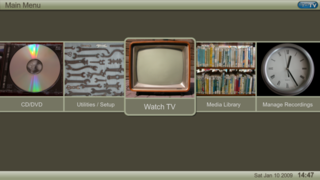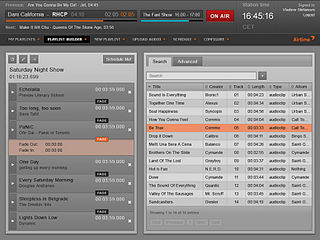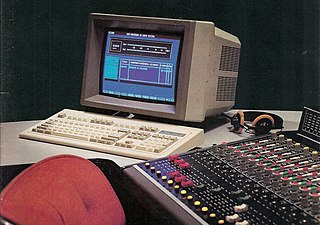Almost all radio stations today use some form of broadcast automation. Although some only use small scripts in audio players, a more robust solution is using a full radio automation suite. There are many commercial and free radio automation packages available.
Radio software allows AM and FM broadcasting to reproduce music and voices from the computer’s hard disk instead of using CD, MD, tape recorders or the old cartridge tape (see Fidelipac). Usually the radio stations stores all advertising campaigns and most of the music in hard disk. Then, instant replay of all the recorded material is done from a keyboard or with a click of the mouse. Now the PC is part of every AM and FM broadcasting, webcasting or podcasting system around the world.
Radio software not only reproduces audio. It is possible to create a “playlist” that can reproduce automatically, without a board operator, a complete radio program, including meteorological announces, advertising campaigns, music tunes, satellite network connection, etc. Then, 24 hours radio stations are possible, also in small towns that can not afford to have operators and speakers all around the clock. Standard PCs are connected in a LAN network to be used on the master control, production, news, administration, etc.
This technology is claimed to be invented in Buenos Aires by Oscar Bonello in 1989. [1] The first radio software for automation, using lossy compressed digital audio codecs, was named Audicom and was internationally introduced at the 1990 National Association of Broadcasters Convention in Atlanta, USA. [2] The world's first radio station to use it was one in San Francisco, California. The basis of the Audicom was the first application, targeted at radio automation, of the audio bit compression technology used to reduce the amount of data. Bonello delivered the first radio automation working technology using the masking curves published by Richard Ehmer. [3]
See also earlier developments of a music scheduling system such as of the US company Radio Computing Services in 1979.
Nowadays with invention of the MP3 bit compression technology and standard audio cards there are a lot of automation software providers at the market. Some systems includes administration facilities for the traffic department, disc jockey schedule, live assist windows and even artificial intelligence automation control.
The basic thing that a radio station does is to broadcast audio to its listeners. Audio can range from a simple talk over, a song or jingle to a sophisticated program with authored content. For profit radio stations rely on advertisements, or commercials, to generate revenue and sustain their operations.
The media database stores details on media files, typically mp3 encoded files. Attributes contain, but not limited to, file name, name of the song or audio file, type of media, its duration, etc...
Media records can have different types:
Media files can be edited prior to playback or broadcast. Typical audio editing features exist in most radio software solutions. In addition, radio software allows users to provide metadata for audio files, such as intro and outro positions within the file.
Some radio software contain multi-track editors that allows users to set the mix between two songs as well as audio volume levels.
Radio scheduling starts with a grid. A grid will contain one or more schedules. Grids span a long time period, usually no less than three months. Schedules will in turn contain a list of programs. Schedules span a short time period, typically one day. Programs are usually one to four hours in duration, typically one hour. Programs will contain a list of program elements. This list of program elements become the play list that radio software loads and automates.
Scheduling songs, external audio, or live shows, differs to scheduling commercials. The scheduler is used for defining program schedules but not to schedule commercials. There is a special module for commercial scheduling.
The commercials module in radio software allows users to link commercials to campaigns and set their schedules for playback at future pre-defined times.
The more advanced radio software solutions allow users to schedule commercials in bulk or through integration.
Is the component of a radio software that allows user to playback media files in full automation or manually on demand. These modules typically contain audio players, a visual representation of the currently playing audio file, a queue of songs to be played in sequence, timers and clocks displays, as well as a browser for audio files in the media database with search capabilities.
News modules are used to create news sessions and news articles which can be read by news readers on air. These modules allow users to attach audio files to the news article to playback during a live news session.
Records audio 24/7 in compressed format, splits, names, and archives files according to a user-defined structure. Radio stations usually maintain at least three years worth of 24/7 recorded broadcast.
This module of radio software allows users to publish an audio stream of the playback to a pre-defined streaming server.
Reports provide users with capabilities to analyze and summarize events generated by users or the radio software itself.

MIDI is a technical standard that describes a communications protocol, digital interface, and electrical connectors that connect a wide variety of electronic musical instruments, computers, and related audio devices for playing, editing, and recording music. The specification originates in the paper Universal Synthesizer Interface published by Dave Smith and Chet Wood of Sequential Circuits at the 1981 Audio Engineering Society conference in New York City.
A music tracker is a type of music sequencer software for creating music. The music is represented as discrete musical notes positioned in several channels at discrete chronological positions on a vertical timeline. A music tracker's user interface is usually number based. Notes, parameter changes, effects and other commands are entered with the keyboard into a grid of fixed time slots as codes consisting of letters, numbers and hexadecimal digits. Separate patterns have independent timelines; a complete song consists of a master list of repeated patterns.

A playlist is a list of video or audio files that can be played back on a media player either sequentially or in a shuffled order. In its most general form, an audio playlist is simply a list of songs, but sometimes a loop. The term has several specialized meanings in the realms of television broadcasting, radio broadcasting and personal computers.

A digital audio workstation (DAW) is an electronic device or application software used for recording, editing and producing audio files. DAWs come in a wide variety of configurations from a single software program on a laptop, to an integrated stand-alone unit, all the way to a highly complex configuration of numerous components controlled by a central computer. Regardless of configuration, modern DAWs have a central interface that allows the user to alter and mix multiple recordings and tracks into a final produced piece.

Audio editing software is any software or computer program, which allows editing and generating of audio data. Audio editing software can be implemented completely or partly as a library, as a computer application, as a web application, or as a loadable kernel module. Wave editors are digital audio editors. There are many sources of software available to perform this function. Most can edit music, apply effects and filters, adjust stereo channels, etc.
MOD is a computer file format used primarily to represent music, and was the first module file format. MOD files use the “.MOD” file extension, except on the Amiga which doesn't rely on filename extensions; instead, it reads a file's header to determine filetype. A MOD file contains a set of instruments in the form of samples, a number of patterns indicating how and when the samples are to be played, and a list of what patterns to play in what order.

MythTV is a free and open-source home entertainment application with a simplified "10-foot user interface" design for the living room TV. It turns a computer with the necessary hardware into a network streaming digital video recorder, a digital multimedia home entertainment system, or home theater personal computer. It can be considered a free and open-source alternative to TiVo or Windows Media Center. It runs on various operating systems, primarily Linux, macOS, and FreeBSD.

Module file is a family of music file formats originating from the MOD file format on Amiga systems used in the late 1980s. Those who produce these files and listen to them form the worldwide MOD scene, a part of the demoscene subculture.
Broadcast automation incorporates the use of broadcast programming technology to automate broadcasting operations. Used either at a broadcast network, radio station or a television station, it can run a facility in the absence of a human operator. They can also run in a live assist mode when there are on-air personnel present at the master control, television studio or control room.

Airtime is a radio management application for remote broadcast automation, and program exchange between radio stations. Airtime was developed and released as free and open-source software, subject to the requirements of the GNU General Public License until it was changed to GNU Affero General Public License.
This glossary of terms used in broadcasting is a list of definitions of terms and concepts related to both radio and television broadcasting, along with the industry in general.
In broadcasting, channel playout is the generation of the source signal of a radio or television channel produced by a broadcaster, coupled with the transmission of this signal for primary distribution or direct-to-audience distribution via any network. Such radio or television distribution networks include terrestrial broadcasting, cable networks, satellites, IPTV, OTT Video, point-to-point transport over managed networks or the public Internet, etc.

Audicom was the first system in the world to record and play audio from a PC computer, beginning in 1988 the era of digital recording that would eliminate recorders from magnetic and cassette tape used for half a century.
In broadcasting, traffic is the scheduling of program material, and in particular the advertisements, for the broadcast day. In a commercial radio or TV station there is a vital link between sales and traffic in keeping the information about commercial time availability.

Disklavier is a brand of reproducing pianos manufactured by Yamaha Corporation. The first Disklavier was introduced in the United States in 1987.
MusicMaster is a music scheduling software produced by A-Ware Software and used by radio, Internet and television stations. Their main office is located in Dallas, Texas.

DVD-Video is a consumer video format used to store digital video on DVD discs. DVD-Video was the dominant consumer home video format in Asia, North America, Europe, and Australia in the 2000s until it was supplanted by the high-definition Blu-ray Disc. Discs using the DVD-Video specification require a DVD drive and an MPEG-2 decoder. Commercial DVD movies are encoded using a combination of MPEG-2 compressed video and audio of varying formats. Typically, the data rate for DVD movies ranges from 3 to 9.5 Mbit/s, and the bit rate is usually adaptive. DVD-Video was first available in Japan on November 1, 1996, followed by a release on March 24, 1997 in the United States—to line up with the 69th Academy Awards that same day.
The Public Radio Satellite System (PRSS) is the interconnected satellite-distributed network managed by NPR, and used by NPR, Public Radio Exchange (PRX), and American Public Media (APM), as well as independent public radio program producers, to distribute programming via satellite to public radio stations across the United States.

OpenBroadcaster is a web-based, open-source system to run community radio and television broadcast transmitters with a simple web interface.